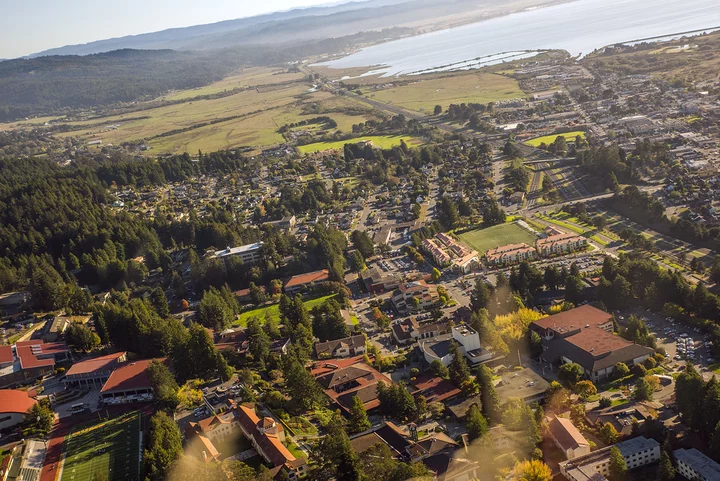An aerial photo of Arcata. Photo from Cal Poly Humboldt.
Although Arcata has built enough housing to meet or exceed all of its new-housing goals for people making less than 120% of its median income, it’s way behind in building housing for households making more than that.
Every eight years, California’s Department of Housing and Community Development gives local governments a number of housing units split up by income level that need to be constructed, called the Regional Housing Needs Allocation (RHNA). Arcata’s way over the threshold for people making 30-50% and 80-120% of the Area Median Income and just five units short for the households in between — but for households earning above that, only 104 out of 262 units have been constructed during this cycle. (If a household spends about 30% of its income on their housing, then it’s considered appropriate for their income level.)
It’s a complex problem caused by more than just one factor, said Arcata’s director of community development David Loya in an interview with the Outpost. There are geographical constraints: Arcata is already densely populated, and both the city and the community don’t have a desire to build out into farms and pastures or into the forest. There isn’t a lot of space left in town to build higher-end condos or houses either.
But even if there was, it’s not cheap to develop it. To make building more housing worth it, the developers have to be able to turn a profit after buying the land and constructing the buildings. And those costs are only going up.
Additionally, much of the single-family housing stock in Arcata is being rented out. Loya said that although that isn’t necessarily a bad thing, it indicates to him that there just hasn’t been enough rental housing built in the last few decades. Many owners of single-family homes have been renting them for decades at increasingly higher prices.
Anecdotally, Loya said when he moved to Arcata in the late ‘90s, some parents of Humboldt State University students would buy houses and pay less on the mortgage than they would if their kids moved into the dorms. When they graduated, they had a money-making asset that returned more revenue than if they had simply put the money into the stock market. A lot of that housing has also deteriorated to the point where purchasing it isn’t an attractive proposition — and it costs more now than it ever has.
“Students are a captive audience,” Loya said. “They are coming here. They have to be here. They have to live here. They can’t live somewhere else and go to the university here. They have to live here. So you can continue to ask higher and higher rent prices for an asset that you don’t have to put much into.”
So Arcata is stuck with a bunch of old, expensive houses that aren’t owned by the people living in them and wouldn’t be easy to fix up even if someone did buy them, making it a much less attractive place to live for high-income professionals such as doctors and business owners who are an important part of keeping the community running. Loya said he knew administrators at Mad River Hospital who were struggling to attract doctors simply because there’s nowhere for them to live.
Loya also pointed out that many Cal Poly Humboldt graduates can’t find a place to live after they graduate, leading to a brain drain and a dearth of innovative businesses.
“When I look back over the history of Arcata, in particular the last 70 years or so, we had a lot of interesting innovators,” Loya said, naming Moonstone outdoor gear, Yakima roof racks, and Wing Inflatables as a few examples. “There was space, housing; there were places to start a business. We’re starting to lose that. Because when people graduate, these innovative thinkers don’t have a place to land in this community. They’re taking their innovation, their smarts, their intelligence, all their experience and expertise, and exporting that somewhere else. So to me, [the lack of higher-end housing] has sort of hard-to-define follow-on consequences that really affect our overall economy and quality of life here.”
Though solutions to the problem won’t be coming any time soon, Loya is hopeful that the opening of CPH’s Hinarr Hu Moulik dorms will open up some housing for purchase. When housing associated with the Gateway Plan starts being built, retirees whose children have moved will also likely move from houses they’re not using much anymore and move into those condos. Some of those condos will also be higher-end. People will shuffle around when they have nicer options, leaving more housing available for redevelopment or for sale.
But of course it’s extremely difficult to predict the future.
“It’s kind of like the difference between climate and weather,” Loya said. “You can’t predict the climate based on the weather today. And I feel like you know what’s happening in the rental market on a day-to-day basis doesn’t necessarily project into what the overall community need is.”

CLICK TO MANAGE